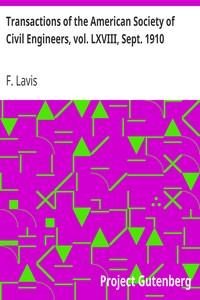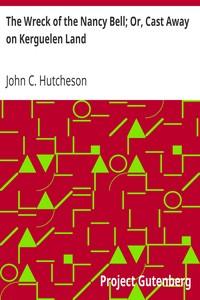|
|
Read this ebook for free! No credit card needed, absolutely nothing to pay.Words: 38762 in 9 pages
This is an ebook sharing website. You can read the uploaded ebooks for free here. No credit cards needed, nothing to pay. If you want to own a digital copy of the ebook, or want to read offline with your favorite ebook-reader, then you can choose to buy and download the ebook.

: Transactions of the American Society of Civil Engineers vol. LXVIII Sept. 1910 The Bergen Hill Tunnels. Paper No. 1154 by Lavis F - Civil engineering Periodicals; Railroad tunnels Design and construction Technology@FreeBooksTue 06 Jun, 2023 American Society of Civil Engineers Instituted 1852 TRANSACTIONS Paper No. 1154 THE NEW YORK TUNNEL EXTENSION OF THE PENNSYLVANIA RAILROAD. THE BERGEN HILL TUNNELS. A general plan and profile of these tunnels is shown on Plate I of the paper by Charles W. Raymond, M. Am. Soc. C. E. At Central Avenue a shaft 212 ft. deep was sunk. It is 3,620 ft. from the Weehawken Shaft. The progress of excavation and lining in the North Tunnel is shown graphically on the progress diagram, Fig. 9, that of the South Tunnel being practically the same. The broken ground of the fault, which consists of decomposed sandstone, shale, feldspar, calcite, etc., interspersed with masses of harder sandstone and baked shale, gradually merges into a compact granular sandstone, which, at a distance of 460 ft. from the shaft, was self-supporting, and did not require timbering, which, of course, had been necessary up to this point. A full face of sandstone continued to Station 274 + 60, 940 ft. from the shaft, where the main overlying body of trap appeared in the heading. The full face of the tunnel was wholly in trap at about Station 275 + 30, and continued in this through to the Western Portal, where the top of the trap was slightly below the roof of the tunnel, with hardpan above. The contact between the sandstone and the overlying trap was very clearly defined, the angle of dip being approximately 17? 40' toward the northwest. The sandstone and trap are of the Triassic Period, and the trap of this vicinity is more particularly classified as diabase. The character of the trap rock varied considerably. At the contact, at Station 275, and for a distance of approximately 200 ft. west, corresponding to a thickness of about 60 ft. measured at right angles to the line of the contact, a very hard, fine-grained trap, almost black in color, was found, having a specific gravity of 2.98, and weighing 186 lb. per cu. ft. The hardness of this rock is attested by the fact that the average time required to drill a 10-ft. hole in the heading, with a No. 34 slugger drill, with air at 90 lb. pressure, was almost 10 hours. The specific gravity of this rock is not as high as that of some other specimens of trap tested, which were much more easily drilled. This rock was very blocky, causing the drills to bind and stick badly, and, when being shoveled back from the heading, as it fell it sounded very much as though it were broken glass. The remainder of the trap varied from this, through several changes of texture and color, due to different amounts of quartz and feldspar, to a very coarse-grained rock, closely resembling granite of a light color, though quite hard. The speed of drilling the normal trap in the heading was approximately 20 to 25 min. per ft., as compared with the 60 min. per ft. noted above, the larger amounts of quartz and feldspar accounting for the greater brittleness and consequently the easier drilling qualities of the rock. The normal trap in these tunnels has a specific gravity varying from 2.85 to 3.04, and weighs from 179 to 190 lb. per cu. ft. The temperature of the tunnels, at points 1,000 ft. from the portals at both ends, remained nearly stationary, and approximately between 50? in winter and 60? in summer, up to the time the headings were holed through, being practically unaffected by daily changes in the temperature outside. At the western end, after the connection with the Central Shaft headings was made, there was almost always a current of air from the portal to the shaft, and ascending through the latter. This tended to make the temperature in this part of the tunnel correspond more nearly with the outside temperature; in fact, the variation was seldom more than 5? Fahr. All the drills used throughout the work by Mr. Bradley were Rand No. 34 sluggers, with 3 5/8 -in. cylinders, and the steel was that known as the "Black Diamond Brand," 1 3/8 -in., octagon. It was used in 2, 4, 6, 8, 10, and 12-ft. lengths; toward the end of the work it was proposed to use 14-ft. lengths, but owing to some delay in delivery this length was never obtained. The starters, 18 to 24 in. long, were sharpened to 2 3/4 to 3-in. gauge, which was generally held up to depths of 6 ft.; then the gauge gradually decreased until it was 1 3/4 to 2 1/4 in. at the bottom of a 12-ft. hole. Frequently, as many as three or four starters were used in starting a hole, and generally two sharpenings were required for each 2 ft. drilled, after the first 6 ft. It is estimated that about 1/4 in. of steel was used for each sharpening, and that there was an average of one sharpening for every foot drilled. Free books android app tbrJar TBR JAR Read Free books online gutenberg More posts by @FreeBooks

: A Pirate of the Caribbees by Collingwood Harry De Lacy Charles J Illustrator - Sea stories; Pirates Juvenile fiction; Adventure and adventurers Juvenile fiction Pirates Buccaneers Corsairs etc.@FreeBooksTue 06 Jun, 2023

: Jokes For All Occasions Selected and Edited by One of America's Foremost Public Speakers by Anonymous - American wit and humor@FreeBooksTue 06 Jun, 2023
|
Terms of Use Stock Market News! © gutenberg.org.in2025 All Rights reserved.






